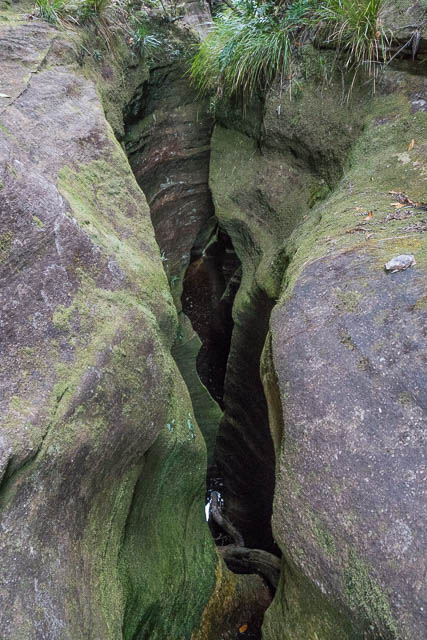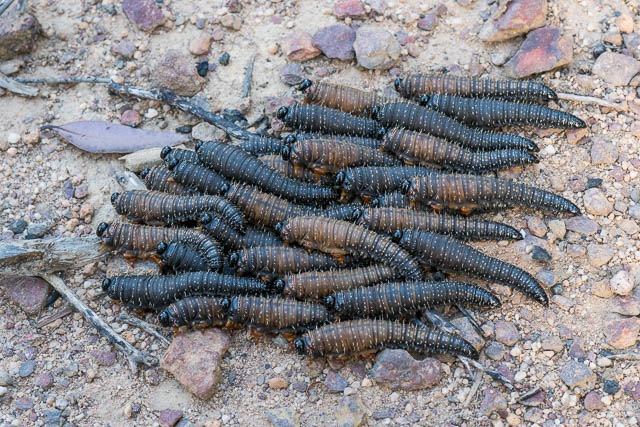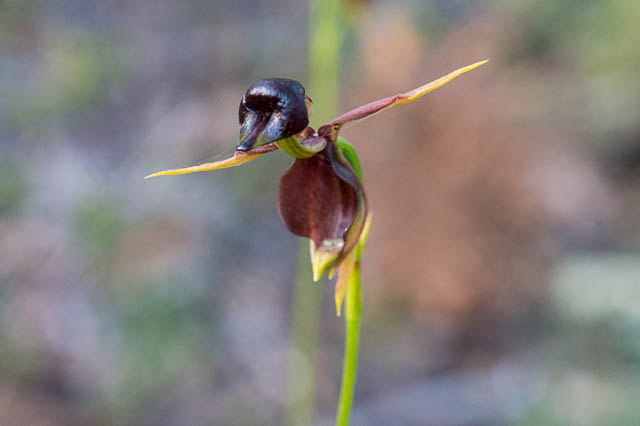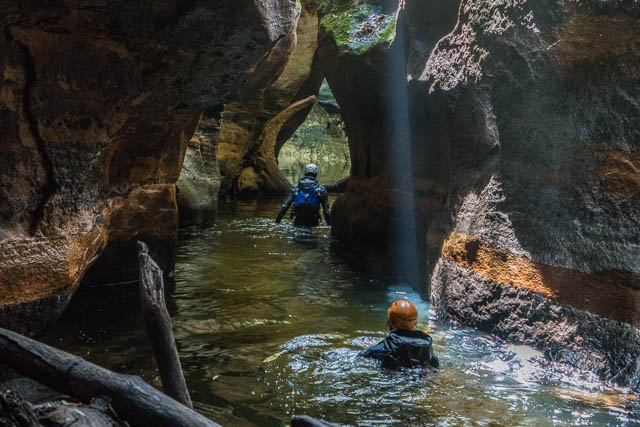This was an excellent weekend of canyoning in the Northern Blue Mountains. On the Saturday I was in a group that visited Banks Canyon in the Wollangambe Wilderness and then we camped overnight at Barcoo Swamp. On Sunday, I joined two more friends for a trip through Rocky Creek Canyon.

Rocky Creek Canyon
Banks Canyon is one of many canyon tributaries of Bungleboori Creek North Branch. It had been a while since my last visit to the canyon (2009). On that trip, our party had earlier on the day gone down Hole in the Wall Canyon, and then after lunch visited Banks Canyon. To do both these canyons is not that much more effort than doing only one of them and is a great day out. But on this trip, I wanted to spend a bit of time photographing in Banks Canyon and we also had a fairly late start (we left the carpark on the Waratah Ridge at 10:45 am).

Martin and Wendy in Banks Canyon
Banks Canyon was first descended in the early 1980’s by Bob Sault and Doug Wheen (SUBW). It is unusual, at the time, amongst canyons in that its major constriction is in the top layer of the Narrabeen Group – the Banks Wall Sandstone (most canyons lie in the lower Burra-Moko Head Sandstone). Since then a lot more canyons have been found in exclusively in this sandstone layer. But according to Bob and Doug, the canyon was named from an incident on the way out, when Doug slid his car off the fire road into a dirt bank. A year or two before the first descent, I had note the canyon on a long bush walk I had led for the National Parks Association. We had earlier tried to go down a creek that is now called “Hole in the Wall Canyon”, but been repelled by the canyon. The trip was in August (1980 or 81?) and we were not keen to swim and we only had a short handline. We scrambled into the North Branch of Bungleboori Creek nearby, camped overnight in a nice cave, and then the next morning climbed to the north via a small dry canyon that went as an easy pass. At the top of this I remember looking down into the upper part of Banks Canyon and noting the slot.

For many years, during the 1980’s and 1990’s, we used to visit Banks Canyon as part of a longer two day canyoning trip – one that we called the “Tetralogy”, where we fitted in 4 canyons on the weekend. We would always start with Hole in the Wall Canyon, then usually do Banks Canyon (both with overnight packs), but sometime we visited Nosedive Canyon, then camp overnight near the Fortitude junction with Bungleboori Creek North Branch. On the second day, we would always visit Crikey Canyon and then usually Froth and Bubble Canyon (or sometimes one like Steep Creek Canyon). These were always excellent trips. Crikey Canyon is undoubtedly the best canyon in the Bungleboori area upstream of the junction of the two branches. I used to rate Banks Canyon as the second finest, but now I think I would rate Hole in the Wall as slightly better. Hole in the Wall is certainly a shorter trip and easier to do, and perhaps one of the best to photograph.

On this trip, four of us set out – Martin, Steffy, Wendy and myself. It took us a bit more than 90 minutes to reach Bungleboori Creek North Branch and then we made a quick crossing and up that same pass to the north that I had use many years before. We had lunch, early in the canyon and then set of down it.

The easy part of the canyon is quite narrow, and you are not sure whether to swim or to bridge a bit above the water. Probably a combination of both is needed. Part way down is an abseil into a very dark section. You cannot see the bottom – but it is only 4- 5 metres down, and you enter another narrow section. Then another awkward drop – a short hand over hand and more narrow going till the canyon opens out and ends. Here we experienced a short thunderstorm.


Then a scramble down boulders to reach the short lower section. This has two abseils – a 35 m rope is adequate for these. The lower one takes you down to the junction with Bungleboori Creek North Branch.


We then headed upstream – through a nice canyon section. Some of the pools here, seem to have got longer during the past few years. This does happen due to shifting sand.



We passed the junction with Hole in the Wall Canyon, and from there it was not far upstream to the pass we had used earlier in the day. We climbed out and reached the car around 7 pm. The walk back was not too bad – the weather was now cooler and there were lots of nice wildflowers – including a huge number of flannel flowers and some nice Flying Duck Orchids. It was also interesting to see two separate “masses” of Sawfly Larvae. The adult form of these are the pollinators of the Flying Duck Orchids.


Sawfly Larvae

Flying Duck Orchid with Robber Fly

Back near the carpark, we noticed some unusual yellow flowers. I recognised them from seeing them in the same spot last year – a rare type of mistletoe that is endemic to the Blue Mountains –

Atkinsonia ligustrina
We then headed to Barcoo Swamp to meet up with Stu and Enmoore.
More photos from the Banks Canyon trip are online on my website here.
We had a pleasant evening around the campfire at Barcoo Swamp. The next morning, Wendy was heading off to a protest at Manly Beach that afternoon against netting of beaches. Martin and Steffy headed off with her. Stu and Enmoore were staying for Rocky Creek Canyon.
We arrived at the carpark at an early hour, but quite a few other cars were there. it was going to be a crowded canyon!

I was keen to do Rocky Creek Canyon on that particular day as it was the 40th anniversary, to the day, since my first trip through the canyon. This was on an exploratory trip on Saturday 4 December 1976. On that trip I was joined by Bob Sault (SUBW and KBC) and Nic Bendeli and Dave Firman (UNSW Bushwalkers). During those days, I had been involved in a lot of canyon exploration in that area. The first canyon we had found was Inverse Canyon (a tributary of Annie Rowan Creek), then Heart Attack Canyon was descended early in 1976. Then, in October, Surefire Canyon was descended. Later in October and November there were exploratory trips to various tributaries of Annie Rowan Creek – with mixed success before thing shifted back to Rocky Creek and its tributaries. I can remember talking to Ted Daniels, who walked with the National Parks Association and had led many exploratory trips to the South Wolgan Area. I can remember discussing Rocky Creek with him. He was of the opinion that bushwalkers has been all the way down it and found no canyon sections. But, nevertheless, we still looked in the creek for canyon. On that trip – we had camped overnight at Barcoo Swamp and then entered Rocky Creek close by. Downstream we had found a short section of low quality canyon that ended with a 20 m abseil (what is now called Sheep Dip Canyon). Late in the day, around 4 pm, we found the main Rocky Creek Canyon constriction. This started at the place where we had planned to climb out. I can remember being delighted to find an easy way down the first drop, that would also allow us to climb back out. So Bob and myself raced all the way through the canyon to the Budgary Creek Junction, and then explored a bit up Budgary Creek to see if it too had a constriction. It did – “The River Caves” – but that was a long way upstream. Finding Rocky Creek Canyon was quite special – the further you went down the canyon, the better it got – deeper and darker. It is still a very lovely canyon by any standard and one of my favourites.


Enmoore had been through Rocky Creek a number of times before, but Stu hadn’t. They set off via Twister Canyon and that would give me more time for photography so I went straight to Rocky Creek Canyon. Doing this also seemed to put me in front of most of the other parties.

I soon caught up to another canyoner travelling by himself and taking photos. I left him in the upper section and travelled down past the slippery waterfall into the better lower part of the canyon. The lighting was quite harsh for photography, but there were quite a few nice sunbeams coming into the canyon. It was nice to see one of the darker corridors of the canyon lit up by an array on sunbeams. They are rare in that section of the canyon. But deep water makes them hard to photograph.


I slowly move to the end of the canyon, and then spotted Enmoore and Stu. They had been going well and overtaken several large commercial groups in Twister Canyon. They competed the last swim in the canyon while I slowly headed back upstream – taking a few more photos. We met up again near the slippery waterfall.







When we reached the start of the canyon, we thought it too early for lunch so we headed back up the track to the carpark. On the way where quite a few more parties heading down to the canyon – a popular place to be on what was by now a very hot day.
For lunch, we headed off to a nearby lookout above Carne Creek.

More photos from Rocky Creek Canyon are online on my website here.

Fabulous photos, David!
Epic stuff and excellent photography
Amazing photography especially the light shafts. Gives me the cold shivers to go down that far. I wonder if any of these canyons are accessible as a day trip without using ropes to go down. Impossible for me.
Award winning adventuring.
You can always go to the Grand Canyon at Blackheath and walk up the canyon from the bottom – easily reached from the tourist track. There is one long swim – so best visited in summer.